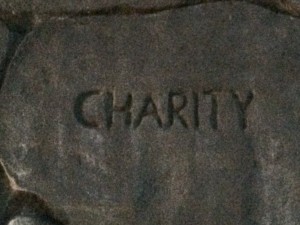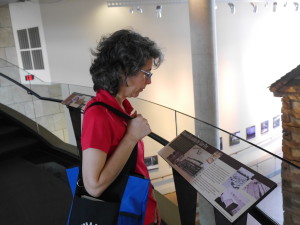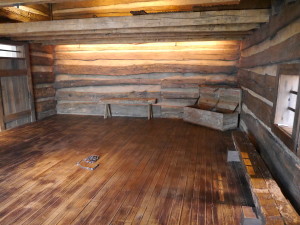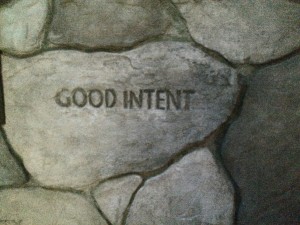Cincinnati is the first stop on my “educational road trip” to learn about the Underground Railroad (read earlier post here). Today we spent our second day the National Underground Railroad Freedom Center in Cincinnati. This is an incredible museum dedicated to shedding light on the history of slavery, the Underground Railroad, and the proliferation of slavery around the world today, in 2015.
I couldn’t even blog yesterday. I was so tired by the end of my first day at the museum. I didn’t even get through the first exhibit. Granted, I read every single placard, listened to many of the audio elements and took a ton of pictures. I was at the beginning of my immersion into this intense topic and I was at my limit.
Good thing I went back today.
The highlights of the day were unexpected opportunities to speak with two people on staff at the museum.
Jackie Wallace (pictured above) the Interim Manager of Education Initiatives, who shared many stories with me about her family, about local history and her life as an elementary school teacher (for 30 years!). One person she told me about is John P. Parker, a man who bought himself out of slavery, started a successful foundry business, and then helped many enslaved people escape across the Ohio River in Ripley, Ohio as they journeyed toward freedom. I am very excited to follow her advice and visit Ripley and the Parker House on Saturday. I bought Parker’s autobiography today and hope to get at least partially through it before the visit.
I also spent an extensive amount of time with Carl Westmoreland (also pictured above), the museum’s historian, who obtained one of the museum’s most prominent artifacts – a “slave pen.” John Anderson, a slave trader who owned the pen, used it to hold enslaved people before marching them to the Ohio River to be sold in Mississippi. Westmoreland spent months combing through public records to document the history of the pen, and then oversaw the dismantling, moving and reconstructing of it inside the Freedom Center.
As I stood inside the wooden structure, I could not begin to imagine the tears and the fury of the people trapped inside who had been ripped from their families to face a terrifying future.
Teaching Students About Slavery
When I taught 8th grade two years ago, my students could not understand slavery and why it happened. I don’t think I had the tools to explain it to them. I still don’t. But the slave pen is a symbol of why slavery endured for so long. Near the pen is a document that John Anderson wrote, cataloging (I thought it was boasting) about what he owned (people and prized race horses were included). The man became wealthy by selling other people for three times the price he paid for them.
I hope I can communicate to my students that kidnapping, transporting and selling human beings made many people very, very wealthy.
Many of the people purchasing enslaved people to work on their farms and plantations profited so much that they were unwilling to consider their source of free labor as anything but chattel. Unless, of course, it came to Congressional representation.
Remember the Three-Fifths Compromise during the U.S. Constitutional Convention? A haunting irony is that southern slaveholders wanted enslaved people to be counted as a possession when it came to laws absolving them of criminality in the way they treated enslaved people, but counted as people (or at least 3/5ths of a person) when it came to Congressional representation. This gave the south much more governmental power (and seats in the House of Representatives) than they would have had if only the free population was counted.
The Center has a reflection room dedicated to commemorating the people who were kidnapped in Africa, and did not survive the Middle Passage. At the center of this small dark room is a lighted pillar of colored glass beads and cowrie shells. Along the walls, made to look like stones, are the names of many of the ships that transported these Africans.
Many of these names are haunting and full of bleak irony: Friendship, Good Intent, Jubilee, Love and Unity, Grace of God and Charity. What a glaring testament to the denial of the Europeans, White Americans and the American establishment, to their dehumanization of the Africans, and to their understanding of the slave trade.
After spending hours immersing myself in all the intense information communicated through the exhibits, it was powerful and meaningful to have a space to pause and reflect on the lives of the people who were enslaved and the ways they – and the history of this country – were forever changed.
Links to all Underground Railroad blog posts:
- Kicking Off My Fund For Teachers Fellowship
- Cincinnati’s Freedom Center (This Post)
- Underground Railroad, Slavery and the Erasure of Memory in Flushing, Ohio
- Unexpected Twist on an Ohio River cruise
- Why Ripley Ohio Moves Me
- A History Hater Teaches History
***
Like this post? Want to follow my trip? How about subscribing to my blog? You’ll get an email each time I write a new post.
#FFTFellow






5 Comments
Michael Taylor, NBCT
June 11, 2015Fascinating journey. Looking forward already to the next installment.
Melissa
June 11, 2015Thanks so much for reading! I will get cracking on #3 soon!
Oz Teitelbaum
June 12, 2015Hi Melissa,
Thanks for sharing your latest entry. I am envisioning John Anderson’s pen and how much weight it had. Also, I appreciate you sharing the story of John P. Parker. It was also helpful to see you mention the Three-Fifths Compromise. The names of the ships was a very chilling reminder of denial as well as the tragic inhumanity.
Safe travels….
Ozer
Morgan Hatch
June 16, 2015So interesting to read your comment that your eighth graders didn’t understand slavery and why it happened. Really shocked me and made me consider what my sixth graders know or don’t know – most teachers treat such profound moments of injustice and tragedy and shameful reckonings with glib attention. And here you are Mel full of conviction to not let yourself go down that path. Got me fired up!
Melissa
June 16, 2015Thanks for the positive feedback, Morgan.
Leave A Response